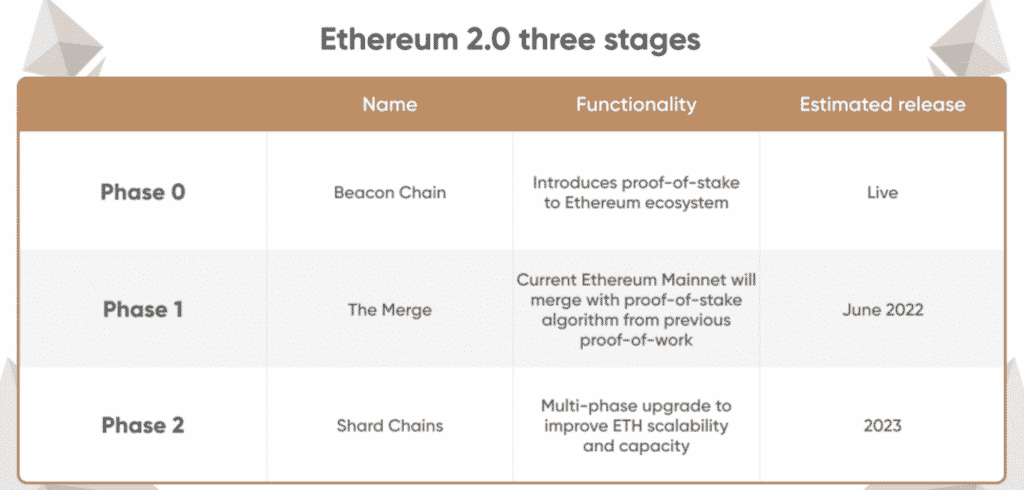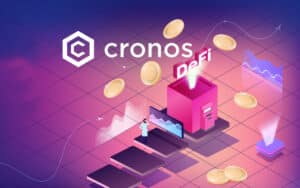While Bitcoin remains the most traded and popular cryptocurrency, Ethereum has arguably been the more influential. For the most part, the project has achieved the primary objective outlined by Vitalik Buterin in its 2014 whitepaper of being a ‘next-generation smart contract and decentralized platform.”
Presently, Ethereum is the second-most valuable blockchain, with roughly 121 million ETH circulating in the markets, priced at about $1,800 each. However, as we know, cryptocurrencies essentially operate on software, which needs constant upgrades.
In the context of Ethereum, the network has experienced a substantial number of users yearly, which has unfortunately caused several issues; this is where ETH 2.0 comes in.
As laid out by the Ethereum Foundation, the mission is to make Ethereum ‘more scalable, more secure, and more sustainable.’
ETH 2.0 is the most anticipated enhancement to this blockchain and, if successful, would be the most significant from a specification perspective since its inception. This article will explore the what, why, and when of Ethereum 2.0 in more detail.
What is ETH 2.0?
Ethereum 2.0 (also referred to as ETH 2.0, Eth2, or Serenity) is a much-awaited multi-staged upgrade to the Ethereum blockchain. Despite consisting of several crucial developments, two significant changes are set to take place: the transition from the proof-of-work (or mining) to the proof-of-stake (PoS) consensus mechanism and shard chains.
The combination of PoS and sharding would drastically reduce network congestion and astronomically increase scalability or speed levels to those on par with Ethereum’s closest blockchain competitors like Solana, Cardano, and Polygon.
Presently, Ethereum faces a number of drastic challenges, namely the following:
- Unusually high gas or transaction costs
- A slowness in transaction processing
- Congestion
- Expensive mining
- Adverse environmental effects
Let’s briefly break down proof-of-stake and shard chains or sharding. Presently, Ethereum relies on mining, the practice of thousands of computers globally coming together to solve complex equations attached to each block in the blockchain.
Despite being more secure, proof of work comes with several drawbacks. The main ones are that it requires expensive equipment and eats up massive amounts of electricity. Staking solves both problems at once.
There is no need for nodes to figure out perplexing computations in a proof-of-stake network as the blockchain autonomously confirms transactions based on how much each user has staked.
Therefore, it doesn’t need any hardware operation and is more eco-friendly. Plus, the protocol can process far more blocks, making each transaction far cheaper. Sharding is a latency-decreasing technique where a blockchain is split into ‘shards’ or smaller chains to spread the network’s load.
Ethereum is set to have 64 shards. This means the network’s executions will not rely on one ledger, which is another avenue for making the entire network more expandable.
The when
It’s worth mentioning that the date of the complete implementation of Ethereum 2.0 is rather tentative. Various reports suggest that the upgrade was initially planned for a 2019 finalization, but, unsurprisingly, many delays have been experienced.
Moreover, as previously mentioned, Eth2 will be rolled out in specific phases. The last step has been rumored to be settled sometime in 2023. Therefore, this is the year when investors and enthusiasts of Ethereum expect the blockchain to be completely enhanced.
Let’s look at the main stages of Serenity. Below is a simple illustration outlining the three prime steps to the upgrade.

- Phase 0, known as the Beacon Chain, is already live and was successfully launched on 1 December 2020. It runs alongside Ethereum, meaning it’s not yet connected to the network. Think of it as the precursor for the entire Ethereum mainnnet finally moving towards PoS.
For now, Phase 0 allows users to stake at least 32 ETH (an enormous amount) to become a validator that will eventually be deployed onto Phase 1.
- Phase 1 is also called ‘The Merge’ as it’s where the Beacon Chain will merge or link into Ethereum, making Ethereum officially a proof-of-stake network and mining completely obsolete. Initially, the Ethereum Foundation had suggested a Q3-Q4 2022 release, but it will likely occur on 08 June 2022.
- Phase 2 will introduce sharding to the blockchain. The Ethereum Foundation hasn’t given a rough month and year for when this will transpire other than sometime in 2023.
There is the possibility for a ‘phase 3,’ the least defined part of Eth2. Think of it as a ‘touch-up’ period tying up any ‘loose ends’ before the entire upgrade is fully operational.
Why the anticipation?
Let’s explore the main things that this upgrade will ultimately bring to Ethereum.
- Significantly reduced transaction costs: From an end-user perspective, the most frustrating pain point about Ethereum currently is the unsustainably high gas fees. With Serenity’s proof-of-stake, the operational costs would be dramatically lowered.
- Increased transaction speeds: Historically, Ethereum has processed around 30 transactions per second. This efficiency rate is not as competitive as with traditional and non-traditional financial technology companies.
Experts predict that Eth2 would see Ethereum process up to 100 000 transactions a second.
- Higher energy efficiency: This one is a no-brainer. Proof-of-stake will make Ethereum 99.9% energy-efficient as mining hardware wouldn’t be necessary to run the blockchain.
- A greater number of validators and decentralization: The Ethereum Foundation envisions a world where users could even run an Ethereum node on their phone. This upgrade will lower the entry barrier for becoming a validator, allowing for more participation, decentralization, and security.
Curtain thoughts
So, what does this all mean for Ethereum? This project has long been regarded as one of the most promising and ‘safer’ investments in cryptocurrencies. Therefore, Ethereum 2.0 should see ETH becoming more valuable than ever before.
We should also realize that developers are working tirelessly, given the unprecedented and revolutionary scale of this endeavor. Therefore, the wait could take longer than 2023. Nonetheless, if the upgrade is eventually carried out successfully from start to finish, fans of Ethereum have a lot to be excited about for the future.



